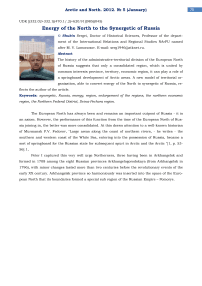Energy of the North to the Synergetic of Russia
Автор: Shybin S.I.
Журнал: Arctic and North @arctic-and-north
Рубрика: Geopolitics
Статья в выпуске: 5, 2012 года.
Бесплатный доступ
The history of the administrative-territorial division of the European North of Russia suggests that only a consolidated region, which is united by common interests province, territory, economic region, it can play a role of a springboard development of Arctic areas. A new model of territorial organization, able to convert energy of the North to synergetic of Russia, reflects the author of the article.
Synergetic, Russia, energy, region, enlargement of the regions, the northern economic region, the Northern Federal District, Dvina-Pechora region
Короткий адрес: https://sciup.org/148320468
IDR: 148320468 | УДК: [(332.02+332.1)(470.1/.2)+620.91](985)(045)
Текст научной статьи Energy of the North to the Synergetic of Russia
The European North has always been and remains an important outpost of Russia - it is an axiom. However, the performance of this function from the time of the European North of Russia joining in, the better was more consolidated. At this draws attention to a well-known historian of Murmansk P.V. Fedorov, "Large areas along the coast of northern rivers, - he writes - the southern and western coast of the White Sea, entering into the possession of Russia, became a sort of springboard for the Russian state for subsequent spurt in Arctic and the Arctic "[1, p. 5356].1,
Peter I captured this very well urge Northerners, three having been in Arkhangelsk and formed in 1708 among the eight Russian provinces Arkhangelogorodskaya (from Arkhangelsk in 1796), with minor changes lasted more than two centuries before the revolutionary events of the early XX century. Arkhangelsk province so harmoniously was inserted into the space of the European North that its boundaries formed a special sub region of the Russian Empire – Pomorye.
Pic 1. The map -scheme-of Archangel province at the end of XIX – at the beginning XX centuries
During the revolutionary elements of the province was disbanded. In 1920 he was created Korelsky labor commune, part of which was included Kem County Arkhangelsk province, a year later, Alexander County Arkhangelsk province was transformed into an independent province of Murmansk. In August, 1921 in the territory of Ust-Sysolskiy, 21 municipality districts Yarenskogo Northern Dvina Province, 19 counties Pechora district of the Arkhangelsk province autonomous region was established and the name was Komi Zyrians.
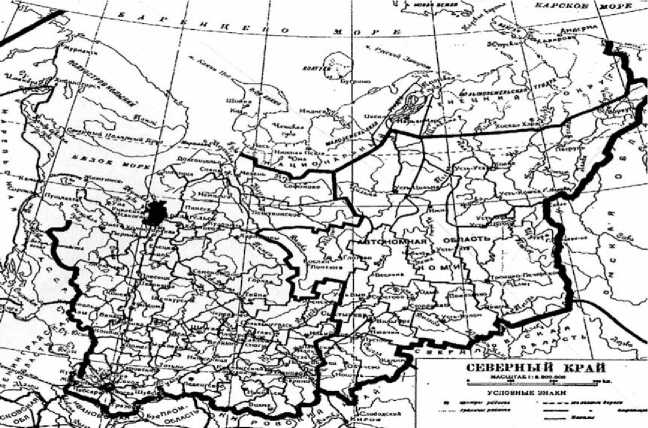
Pic. 2. The map -scheme-of Northern region (1929-1936.)
The New Economic Policy introduced dramatic changes in the nature of the regional government. As a result, in the late 1920s and 30s the European territory of the North was again united under the name of the Northern Territory in the Arkhangelsk, Vologda, Severodvinsk provinces, autonomous region of Komi and the Nenets Autonomous District.
It was during these years was made a major new breakthrough in the northern high- latitude Arctic, the decisive steps taken by the Northern Sea Route. During the Great Patriotic War, the region once again functioned essentially as a whole. Post-war regional fragmentation of the European North tried to overcome in the Khrushchev years through the creation of economic councils. совнархозов.
In November 1982 the Council of Ministers of the USSR was formed a new district - the
Northern economic region in the Arkhangelsk, Vologda and Murmansk regions, Karelia, Komi
ASSR and that the same actions had been excluded from the North-West economic region.
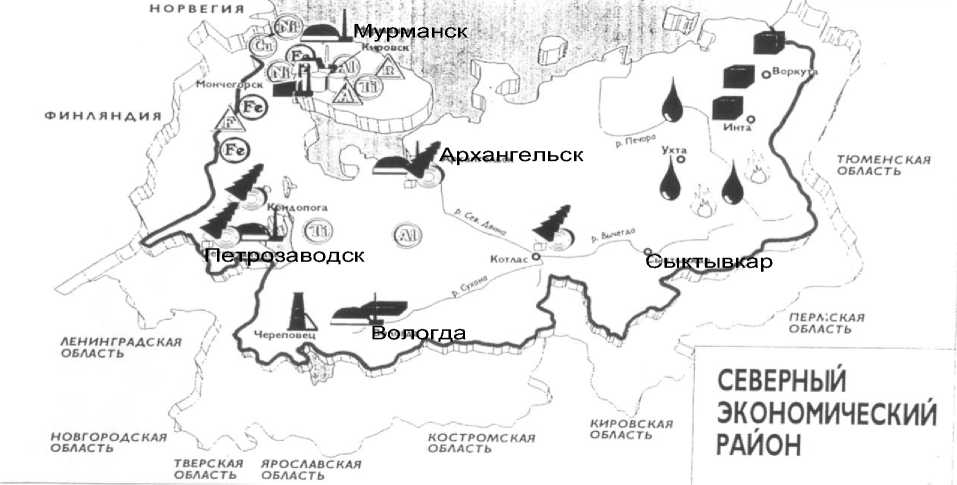
Pic 3. The map -scheme of the Northern economic region
A new area has been allocated from the North-West district based on the following reasoning: "... in connection with the specification of the specialization, the emergence of new centers of economic gravity, and links the formation of new territorial-wide economic entities - the Timan-Pechora RIC, is the creation of many industrial centers and nodes "1. It is interesting to note that the decision was made after coming to power of Yuri Andropov, the man is deeply understands the laws of domestic and international development.
This historical review, in our view, indicates that at present, a new stage of the European North of the Arctic in order to achieve greater agility should be consolidated much more thoroughly than is the case in the current situation.
It's not a secret that the northern component is substantially lost their weight in the country after the abolition of the State Committee for Northern Affairs, and as it turns out now, at a time when other Arctic countries is just really took care of their northern development strategies. The inclusion of the Northern economic region (composed of the Arkhangelsk, Vologda and Murmansk regions, Karelia, Komi and Nenets Autonomous District) in the North-West Federal District disputed and contested by many experts2.
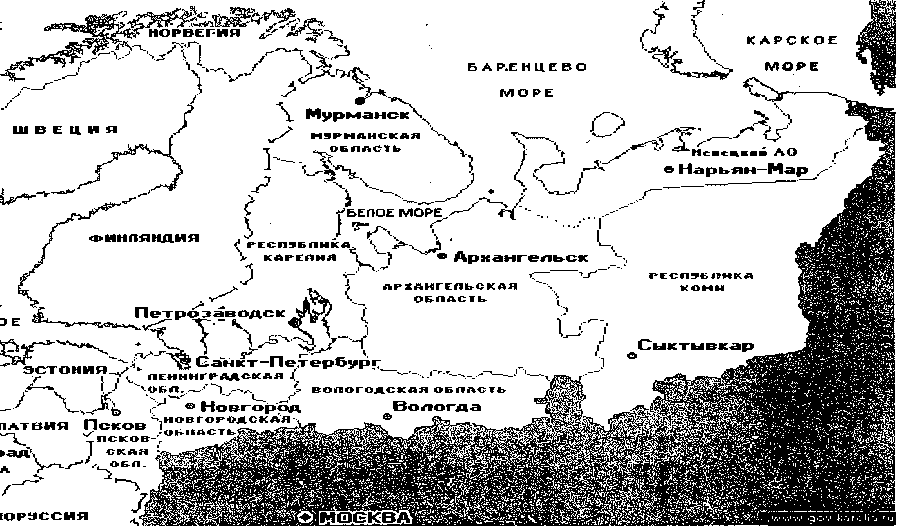
Pic. 4. The map – scheme of the North - Western Federal region
As a result of this decision (lack of thoughts have a proven history of the 1920s and 1980s) was largely lost interest in the European North as an important vector of internal and external policy of Russia. According to many analysts, the need for greater attention to regional policy in the European North explains gaining importance in the idea of forming a so-called before Northern or sub polar surface area as a kind of springboard, springboard for the development of the Arctic [2, p. 22].
The most comfortable fit, and the vast region of before norhern zone is the European North of Russia. This, in particular, drew attention to a well-known contemporary Russian geopolitics A.G. Dugin, "Arkhangelsk and the Arkhangelsk region are in the strategic position that is most consistent with the principle of strategic integration of the North in the interests of the center. Axis of Moscow - Arkhangelsk, the only full range of internal "geopolitical ray" is not just a military and strategic construction. It is necessary to maximize the integration of diverse and the South up to Moscow. Migration of the Russian population ... to the North, its active exploration, development and transformation should begin with this Archangel. This is the largest port in the most advantageous position in comparison with all other settlements of the North, so it is most logical to select the Archangel as the "capital of the Arctic pact" [3, p. 317].
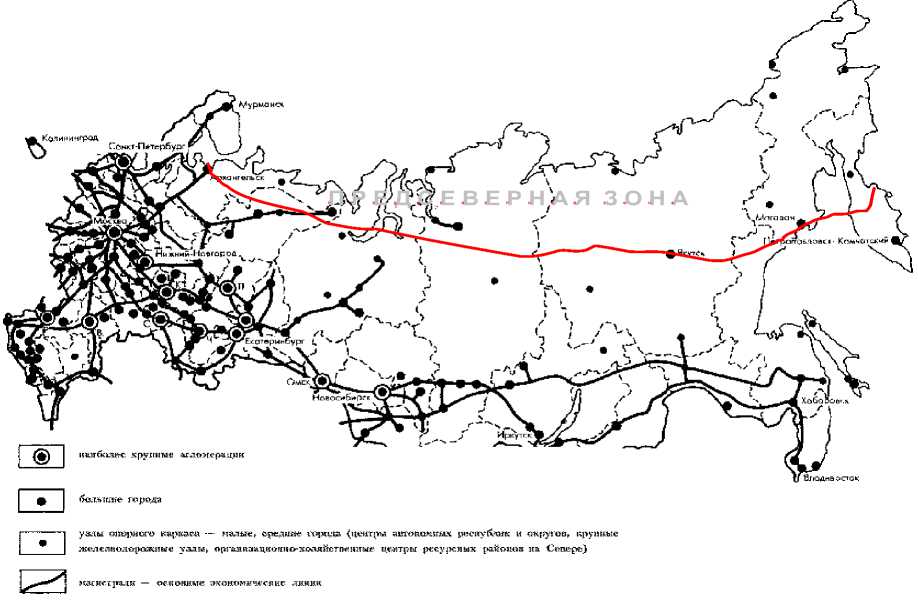
Pic. 5. The map – scheme of the reference frame with the liberation of Russia before Northern zone
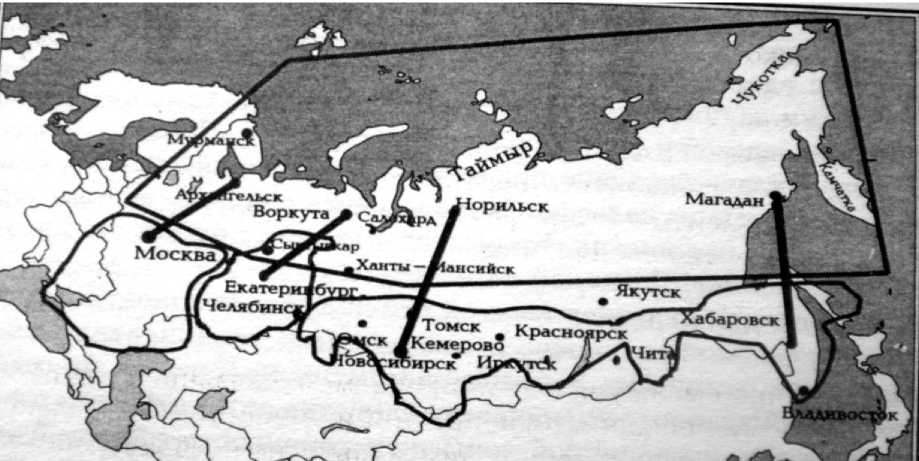
Pic.6 The map – scheme of the main of the major axes, which are connecting «the arctic trapezia » with mainland of Russia
The development of the axis of Moscow - Arkhangelsk should be comprehensive and prioritized. The quality and the dynamics of this single (out of the North) meridian of integration will depend on the consistency and efficiency of the entire Arctic strategy.

Pic. 6. A schematic map reflects the role of Archangel in providing geo-political interests [3, p. 322].
It is no accident, that one of the mechanisms of formation and realization of state policy in the Russian Federation in the Arctic up to 2020 provided the consolidation strategies of socio-economic development of northern regions of the Russian Federation, the development of territorial planning schemes and programs of socio-economic development. The question is how to provide the necessary consolidation of the European North?
In our view, we can consider two possibilities: either the formation of the Northern Federal District within the boundaries of the Northern economic region, by area, by the way, coinciding with the U.S. Alaska, or enlarged in the region under the code name Dvina-Pechora region, which could unite the Arkhangelsk region, Komi Republic and Nenets Autonomous District.
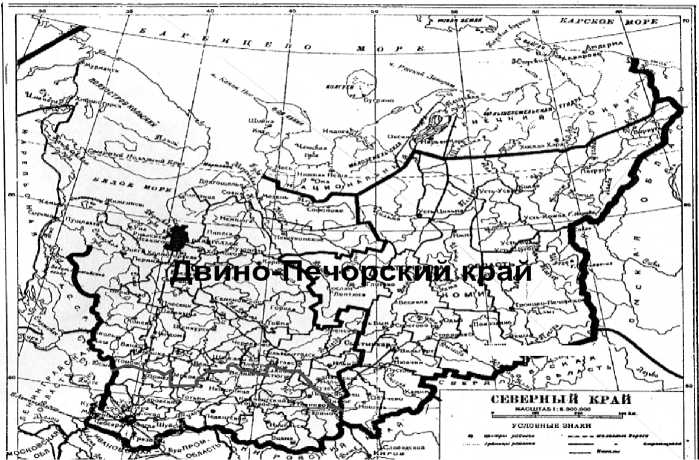
Pic. 7. A schematic map of Dvina-Pechora region, bringing together the Arkhangelsk region, Komi Republic and Nenets Autonomous District
Both options do not seem utopian and depend on the choice of strategy for regional devel- opment of the Russian Federation and, of course, from the political will and the central government interest - is the regional.
The Complex formation in support of the Northern economic region (Arkhangelsk, Murmansk and Vologda regions, Karelia, Komi and Nenets Autonomous District), Northern Federal District was the very real challenge due to the fact that in the south of the decree of Russian President Dmitry Medvedev on January 19 2010 was formed a new, eighth - North Caucasus federal district.
Thus, the ten-year taboo on the so-called "council of seven" was overcome. In the corridors of power of the federal re-actualized the problem of improving the spatial structure of Russia, including in the North West. If the central government intends to continue to use the regional government of the country the federal district, the need for the provision of the North-West Federal District of the North is not in doubt.
Russia, as you know, after the collapse of the Soviet Union became more northern country, made a lot of efforts to create a northern strategy, and institute a springboard for the development and implementation of the strategy of the Arctic there. PV Fedorov, not without reason, calls attention to the contradiction "between ... attempts to justify the status of the Russian Arctic and the policy of submission the territory of the Russian North the interests of the Baltic Sea region" [4, p. 3]. At this time drawn the attention of the ex-governor of the Novgorod Region Mikhail Prusak. Is St. Petersburg, the most western city of mainland Russia, will be engaged in the Russian North? Not at all. He, like all the obvious problems of its own - the Baltic. It would be nice if he decided they were not at the expense of the northern territories. And the fact that this is the case, and not otherwise, we northerners are well aware of the example and the port of Arkhangelsk and Severodvinsk. Incidentally, the construction of the railway BELKOMUR (Arkhangelsk -Syktyvkar - Perm) was terminated immediately after arrival in the capital of St. Petersburg team, headed by Vladimir Putin. Therefore, the Northern Federal District - The best model is an effective institution for the development and implementation strategies of northern Russia.
One of the most authoritative experts in the field of Russia, Professor regionologii Turov-sky, for example, explicitly says: "Expediency is the division of the North-Western District in accordance with an exemplary ex-economic regions, ie, actually the North-West District, with its center in St. Petersburg (including Kaliningrad region) and the Northern district of Arkhangelsk center "[5, p. 245]. This approach, in his opinion, would preserve the possibility of state regulation of the northern regions of the country.
The second option - option of consolidation - must be borne in mind first of all, because the unknown prospect of federal districts themselves. It's no secret that the creation of seven federal districts in 2000 was seen very clearly, to analyze, much less to question. The decision of the President of the Russian Federation D. Medvedev on the establishment of the eighth - the North Caucasus - District, perceived by many as a "very wise decision" for the duration of his presidency, gives cause for serious reflection on the structure and content of Territorial Administration. First and foremost, the problem is updated on the prospects of the federal districts.
The fact that neither the Constitution nor federal law, these powers not spelled out. Therefore, some districts offer regionovedy eliminated, given that the candidatures for the post of regional leaders now offered from the center and can be released by the president. The process of enlargement of the regions can also go to other than authorized representatives of the president.
Therefore, they are quite expensive institution, according to many experts, has lost meaning. Not by chance on a new president drew attention to the leader of the party "Right Cause".
Others offer to leave the task of coordinating the federal districts of the socio-economic activities at the district level. But for this it is necessary to make appropriate laws that would have given additional authority to the district in the area of budgeting, taxation, etc. In this case, the problem of optimality boundaries of federal constituencies. Their borders, according to the doctor of economic sciences, professor of St. Petersburg R.I. Islyaeva do not correspond to the territorial division of labor in the country, "subjective" some of the districts are too cumbersome and does not meet the requirements of the theory of governance ... The district boundary adjustment - a near future [6, p. 15].
The reform of territorial administration in the south may have continued mirror in the North. Many believe that districts should be in number, at least not less than the economic areas. In the formation of the eighth - the North Caucasus federal district just had to take into account these factors. A. It is no accident that Khloponin functions in addition to the presidential envoy was promoted to Deputy Prime Minister and the new district boundaries almost coincide with the boundaries of the economic area.
But the envoys of deputy prime ministers do not work, so the third, experts believe that the federal district should be preserved as bodies from purely administrative functions, conducting independent oversight of the regional authorities. In this case, the border can be left unchanged.
The process of enlargement of the regions - a phenomenon in the transition from administrative to economic methods of territorial management objective, but it should be approached very carefully, taking into account the scientific, practical experience, both international and domestic.
There is a pattern: when the country is controlled by the administrative-command methods, the process of fragmentation of the regions, for guidance in the field must be carried out quickly and only in accordance with directives from above. Local officials, however, as the center, are interested in reducing the area of responsibility, so increasing the number of officials at all levels is growing and the number of administrative-territorial units. In essence, dividing the country into small administrative units - a legacy of dictatorships: it's more convenient to carry out military and police surveillance over the country. For example, Spain under Franco, too, was divided into small administrative units.
Conversely, when the fore the economic management methods, shows a different pattern: the consolidation of administrative and territorial entities that are socially and economically tend to be, at least, amateur, up - self-sufficient. Center in this case becomes a kind of manager who performs the tasks that are not on the shoulder within the regions.
So it was during the years of the new economic policy during the Khrushchev consolidated economic councils, finally, the current economic areas mainly formed during the Kosygin reforms. The process of regional enlargement is completed, or in many countries: France, Italy ... In Poland, for example, the preparation of such a reform took seven years (from 1990 to 1997.). Today, instead of 48 provinces there are only 16. And in recent years - major successes in the economy, which brought her among the most dynamic economies in Europe3.
Another thing is that our authoritarian, not afraid of the competent authority and continues to fear the amateur and the more self-sufficient regions, and therefore are always folded territorial reforms without bringing them to complete and return the country again and again to the authoritarian vertical with lots of small administrative units.
If we take into account the irreversibility of this transition to a market economy, the need for enlarging the regions in Russia, too, should recognize the inevitable. Only a strong regional elite of large self-contained regions can reasonably build relationships of government, business and the people entrusted to the territory and the center of force to reckon with it, which is important in the process of democratization, regionalization and decentralization of power. No coincidence that one of the most respected regional leaders of the Russian Federation, Kemerovo Governor A. Tuleyev - produced a supporter of regional enlargement. "The less of you, the bosses - he argues - the freer economic life" [7, 2004]. The same write-known scientists Senchagov V., V. Da-dalko, A. Bagin applied to the whole of Russia: "The union of regions is necessary and must be carried out within the framework of optimizing the structure of government as a whole, taking into account the solution of economic problems. In the case of combining the conditions for the normal functioning of the territory, the optimal number of regional officials. As a result, should form a more transparent, efficient and inexpensive system of government "[8, p. 10].
Absolutely right, in our opinion, the AG Dugin, when he writes: "This would give the North from the center of considerable independence, freedom from control in detail provisions for regional development of flexible and rapid response of the investment. At all these levels supports the need for integration of the North. This is important in the spiritual, ethnic, cultural, military, strategic, industrial, social, and financial terms. The result of this multi-level integration (as long as existing only potentially) would create an entirely new geopolitical reality in which a significant increase in autonomy and regional autonomy would not weaken the strategic communication with the center. Development of the North would be through the future, an entirely new bridgehead (based on geo-politics) understanding of the space in the long run. Severnaya Zemlya was to develop a combination of tradition and development, loyalty to the roots and technological modernization "[9, p. 312-313].
Of course, this process is not easy, it requires much more attention, a reasonable political, intellectual, legislative, administrative, financial, economic, informational efforts by, above all, the federal government. The easiest ways to let it take its course of consolidation areas, as happened in the zero years of the XXI century, and then seek an explanation for the lack of efficiency in some objective factors.
To create a common space in the North European Russia should seek, above all, common interests and incentives. One of the unifying ideas of the European regions of the north, among others, would be to develop a common position in the construction of transport corridors in the proof of Belkomur and BarentsKomUr.
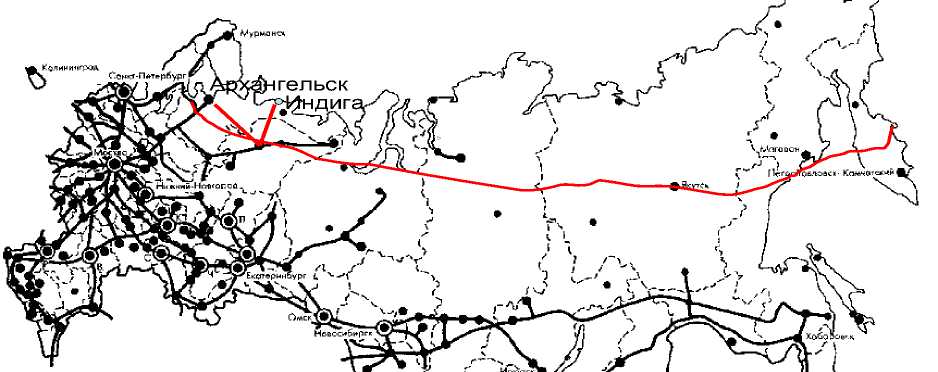
Pic. 8. The map-схема of the reference frame with the liberation of Russia before Northern zones and corridors: BELKOMUR and BARENTSKOMUR
The fact that, according to economists, the term available in the North and even in NorthWest ports will not be able to process the growing volumes of cargo. And Indiga port, for example, the most easterly ice and deep-water port, incommensurate opinions, will be needed eventually. Therefore it is absolutely correct leadership of the NAO put the issue on the agenda. But it is more reasonable to solve it together.
The second reason is the need for consolidation of the gradual transition of the Russian federalism of nation-building to the principle of territorial and state. In the current environment of public authorities, ethnic formations, and especially business-oriented structures are not so much on the preservation of ethnic groups, how to obtain the greatest possible profits from the exploitation of natural resources. The question arises as to whether the interests of a native population of the Russian North preserve the independence of the national-territorial autonomous entities? Out of this situation, in our view, lies in the way of state and decentralization of ethnicity.
And to begin this process is not logical from the South and the North, as in the North a different mentality. "It is home to quiet, far-sighted people who can understand your opponent, step over in favor of a private common. It is inherent in the people of northern Russia, Alaska, American, European, and Scandinavian. Pomors ... always lived fully. This is their main strength: the strength of character and strength of Russia. This then have psevdo liberalov in troubled times emerged the idea that all people should be evicted from the north. Such wise men must not be allowed to manage even the tricycle! "- Writes Academician E.P. Velikhov [10, p. 17]. The harsh climate and closely pressed people to each other. Despite the harsh and cold climate of nature, in the North of human relations climate is warmer than the South and vice versa [11, p. 109].
Another reason for consolidation lies in the need for alignment of regional development. The world is a catastrophic situation where per capita GDP of a region of the country's GDP than the other 5 times. We have the figure as high as 25 times. "This is a clear sign of economic collapse," - said the deputy director of the Institute of Applied Mathematics George Malinetskii. Here's how, with bitterness, writes about this in the homogeneous-Artist of the USSR Oleg Basilashvili: "The huge expanse known as Russia, there are several cities who live by the sale of gas and oil. Everything else is almost extinct, "[12, 2008].
This thesis can be attributed directly to a large part of the northern territories, which are a result of the transition to a market economy were hit the hardest, because their development was largely due to budgetary subsidies. The hopes of reformers in a purely market-based economy are clearly not justified. Moreover, our oligarchs, I think, Goskomsever, Ministry of the Environment prevented "master in his own" northern territories, and therefore were eliminated .
Finland, Sweden, Norway, Canada, the United States do not spare funds for the development of northern territories, recognizing that the future funding. Russia operates the North; it seems, not for, but at the expense of the future. And finally, we should not forget that most of the North - the border and the border areas [13].
«Overhaul of regional governance - one of the conditions for the revival of Russia, - emphasized the country's famous economist and geographer G.M. Lappo. - Rationalization of the territorial unit - an important reserve for its development. If Russia wants to exist as a state, its authorities should pay serious attention to the territorial unit. Given that will continue to use the rich resources of the North; you must pay close attention to the North in general and effective policies in the North in particular, "[2, p. 22].
Undoubtedly, an important role in the unification process could play Northern (Arctic) Federal University named after M.V. Lomonosov. Its creation should be treated as a first step towards understanding the significance of the federal government in the implementation of the European North of the Arctic strategy. The task of the political establishment of Arkhangelsk, intellectual and business communities is that for the first step followed by the solution is not less important for the consolidation of the region.
In one of his last works of renowned scientist and former director of the Institute of Physiology, Arkhangelsk and natural adaptations of UB RAS A.V. Tkachev, untimely deceased, wrote, and in fact, commanded: "The North is vulnerable because there is no general concept of Northerners ... "[14]
It is time for its formation, as the mainland continues to deteriorate, "patchy" European North will not be able to fully fulfill its role as a bridgehead in the implementation of the strategy of Arctic Russia. It is necessary, without going to extremes, as has happened in the past, to ensure that the consolidated power of the northern regions provide synergies of Russia!
Список литературы Energy of the North to the Synergetic of Russia
- Fedorov P.V. Center and the northern outskirts of the Russian state in XVI-XX centuries: Dynamics of strategic alliances (for example of the Kola Polar). Diss. on research. Account. Of Art. Doctor of History. Sciences. Arkhangelsk, 2009. p. 55-56.
- Lappo G.M. territorial structure of Russia in the beginning of the XXI century / / Geography. In2002.-№33.-p.22.
- Dugin A. Fundamentals of Geopolitics. The geopolitical future of Russia. Think space. M., 1999.p.317.
- Fedorov P.V. The Center and the northern outskirts of the Russian state in XVI-XX centuries: The dynamics of strategic alliances (for example of the Kola Polar) / Author. Doctor. thesis. Arkhangelsk, 2009.p.3.
- R. Turovsky Federal District: the political-geographical approach to the theory and practice// Federalism. - 2003. - № 1. - p. 245.
- The State and municipal management: regional-economic determinants / Ed. RA Islyaeva. -Saint-Petersburg, 2002.p.15.
- Kapitonov A. Do the Russia need subjects - matreshki? / / Rossiyskaya Gazeta. In 2004. May13.
- Senchagov V, V. Dadalko, Bagin A. Consolidation of Regions: goals and realities / / Federalism. - 2004. - № 3. - p. 10.
- Dugin A.G. Basics of geopolitics. M., 1997. p. 312-313.
- Velikhov E. / / Pomeranian capital (Arkhangelsk). - 2010. - № 11. - p. 17.
- Stanislav chidori. Reflections on the northern mentality / / North. - 1997. - № 11-12. - p. 109.
- O.Basilashvili. To kill a slave in yourself / / Arguments and Facts. - 2008. - № 49.
- The logic of the President Sh. Sultanov understandable. And it is true. URL.: Http://www.russia-today.ru/archive/2004/no_20/20_topic_1.htm (05/01/2011). 14. Tkachev, AV / / Proceedings. In 2004. April 30.

